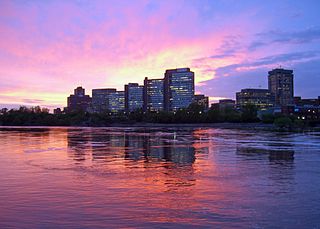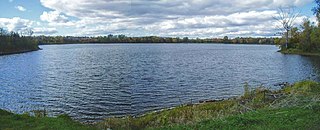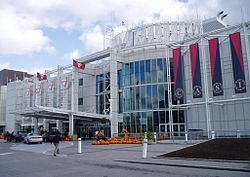
Gatineau is a city in south western Quebec, Canada. It is located on the northern bank of the Gatineau river, immediately across from Ottawa, Ontario. Gatineau is the largest city in the Outaouais administrative region and is part of Canada's National Capital Region. As of 2021, Gatineau is the fourth-largest city in Quebec with a population of 291,041, and a census metropolitan area population of 1,488,307 making it the fourth largest in Canada.

Hull is the central business district and oldest neighbourhood of the city of Gatineau, Quebec, Canada. It is located on the west bank of the Gatineau River and the north shore of the Ottawa River, directly opposite Ottawa. As part of the Canadian National Capital Region, it contains offices for over 20,000 civil servants. It is named after Kingston upon Hull in England.

The National Capital Region, also referred to as Canada's Capital Region and Ottawa–Gatineau, is an official federal designation for the Canadian capital of Ottawa, Ontario, the neighbouring city of Gatineau, Quebec, and surrounding suburban and exurban communities. The term National Capital Region is often used to describe the Ottawa–Gatineau metropolitan area, although the official boundaries of the NCR do not correspond to the statistical metropolitan area.

Gatineau Park is a federal park located in the Outaouais region of Quebec, Canada. Administered by the National Capital Commission as part of the National Capital Region, Gatineau Park is a 361 square kilometres (139 sq mi) wedge of land extending north and west from the city of Gatineau. With a perimeter of 179.2 kilometres (111.3 mi), the park includes parts of the municipalities of Chelsea, Pontiac, La Pêche, and the City of Gatineau. The main entrance to the park is 4 kilometres (2.5 mi) north of downtown Ottawa, Ontario.

Gatineau-Ottawa Executive Airport is an international airport serving Gatineau, Quebec, Canada, and its metropolitan area known as the National Capital Region.

The Hull–Chelsea–Wakefield Railway was a 33 km (20.5 mi) heritage railway in Quebec, Canada, running tourist trains through the scenic Gatineau Hills and beside the Gatineau River between Hull and the tourist town of Wakefield from May to October, using a 1907 Swedish steam locomotive, E2 class number 909, and 1940s-built Swedish passenger cars. On average, the railway attracted about 50 000 tourists and generated revenues of about $8 million for the region.

Loto-Québec is a crown corporation in the Canadian province of Quebec. Established in 1969, it is responsible for overseeing lottery and gaming in the province.
Autoroute 5 is a short controlled-access Autoroute in the Outaouais region of western Quebec. It connects the central urban area of Gatineau with the recreational areas of Gatineau Park and the exurban rural areas of Chelsea and La Pêche. The southern terminus provides access to the Macdonald-Cartier Bridge, which continues into downtown Ottawa. The A-5 generally has four lanes of traffic with the exception of southernmost section across the Macdonald-Cartier Bridge where A-5 widens to six lanes.

Leamy Lake is a lake in the Hull sector of Gatineau, Quebec, Canada. The lake is located just to the south of the Gatineau River, and just west of the Ottawa River, and is linked to both of them with flowing in from the Gatineau and exiting to the Ottawa. To the south is the Lac de la Carrière, a former quarry that is now a lake that is also linked.
Marc Bureau is a Canadian politician, who was the mayor of the city of Gatineau, Quebec from 2005 to 2013.
Edouard Adeceus "Eddy" Bourque was Mayor of Ottawa in 1949 and 1950.

The Rapibus is a bus rapid transit system for the Société de Transport de l'Outaouais (STO) in the city of Gatineau, Quebec. Construction was completed in the summer of 2013 with service beginning in the fall. The Rapibus aims to speed up the service for commuters in growing sub-divisions in the northern and eastern areas of the city by alleviating the congestion on key arteries currently served by bus-designated lanes. A direct link to Ottawa is included.

The Casino de Charlevoix is located in Pointe-au-Pic, now part of La Malbaie, about 150 kilometres (93 mi) east of Quebec City. The historic Manoir Richelieu hotel is located right next to the casino. Charlevoix is a very popular tourist destination because of its location, next to the Saint Lawrence River and the Laurentian mountains.

The Société des casinos du Québec is a subsidiary of Loto-Québec, a government of Québec corporation. The Société des casinos du Québec oversees all four government-run casinos in the province of Québec: the Casino de Montréal, the Casino du Lac-Leamy, the Casino de Mont-Tremblant, and the Casino de Charlevoix.

Tourism is the fifth-largest industry in Quebec. Some 29,000 companies are involved in the industry, generating 130,000 direct and 48,000 indirect jobs. In 2006, Quebec welcomed 3.2 million foreign tourists, most of them from the United States, France, the United Kingdom, Germany, Mexico and Japan. Quebec's French heritage sets the province apart from the most of Canada and the United States, as well as Mexico. The province has preserved its Francophone culture with a European feel.
The Action démocratique du Québec (ADQ) party ran a full slate of 125 candidates in the 2007 provincial election and elected forty-one members to become the official opposition in the National Assembly of Quebec. Many of the party's candidates have their own biography pages; information about others may be found here.

Andrew Leamy was a pioneer industrialist and community leader in Wright's Town, Lower Canada, which became Hull, Quebec and is now incorporated into the City of Gatineau in the National Capital Region of Canada.
Robert LeSage is a Canadian retired politician and civil servant. He served in the National Assembly of Quebec from 1989 to 1998 as a member of the Liberal Party. His name is sometimes given as Lesage.
Ottawa Fashion Week is a nonprofit event which takes place in Ottawa, Ontario, Canada biannually, in February and September. OFW is a platform for local and international designers to showcase their fashion creations, both to the citizens of Ottawa and to visitors to the Canada's capital city from around the world. Since its beginnings in 2003, OFW has grown each year, and includes major fashion productions. It is a business opportunity for members of the fashion and art industry as well as a venue for career growth for designers and artists.
Gambling in Quebec includes Casino gambling in most crowded cities of the region, Lottery, Société des casinos du Québec and Sports betting. Games of chance have existed during the prohibition era but became legal in Quebec only in 1985 when gambling was made legal in the country. Unlike most Canadian provinces where the minimum age for gambling is nineteen, in Quebec, along with Alberta and Winnipeg, you can play from the age of eighteen.
















